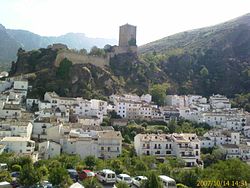Cazorla
| Cazorla | |||
|---|---|---|---|
| city | |||

Cazorla with the Yedra Castle at background.
|
|||
|
|||
| Location in Spain | |||
| Coordinates: 37°54′N 3°0′W / 37.900°N 3.000°W | |||
| Country | Spain | ||
| Province | Jaén | ||
| Municipality | Cazorla | ||
| Area | |||
| • Total | 303 km2 (117 sq mi) | ||
| Elevation | 826 m (2,710 ft) | ||
| Population (2006) | |||
| • Total | 8,173 | ||
| • Density | 27.0/km2 (70/sq mi) | ||
| Time zone | CET (UTC+1) | ||
| • Summer (DST) | CEST (UTC+2) | ||
Cazorla is a city located in the province of Jaén, Spain. According to the 2006 census (INE), the city had a population of 8,173 inhabitants.
Cazorla lies at an elevation of 836 metres on the western slope of the Sierra de Cazorla. It is the entry point and base for visits to the Natural Park of Sierras de Cazorla, Segura y Las Villas Natural Park, a vast protected area of magnificent river gorges and forests. Spain's second longest river, the Guadalquivir, has its source in the mountains to the south of the settlement.
Distances to nearby cities are: Jaén, 121 km.; Granada, 205 km.; and Linares, 71 km. See Mapa de Carreteras de Jaén
The town is constructed around three main squares, the Plaza de la Constitución, the Plaza de la Corredera (or de Huevo, "of the Egg", because of its shape), and the Plaza Santa Maria. This last square is the oldest and is connected to the other two by narrow, twisting streets. It takes its name from the old cathedral which, damaged by floods in the seventeenth century, was later burnt by French troops. It is now in ruin. Above the square sits an austere, reconstructed Moorish castle tower called La Yedra. Still higher up on the rocky escarpment lie the ruins of still yet another ruined fortress.
A recommended excursion is to the nearby village of La Iruela, which has a ruined Moorish fortress perched on a daunting rock peak. A number of battles were fought here during the Reconquista until Don Rodrigo Jimenez de Rada, archbishop of Toledo, reconquered it in 1231 and made it the seat of his archbishopric.
Its primitive structure is relatively intact. The principal defenses consist of a crumbling principal tower and two separate enclosures, with some of its battlements still intact, connected by a long curtain wall. These walls also protected the monastery, whose remains are still visible nearby. See Castles
...
Wikipedia



